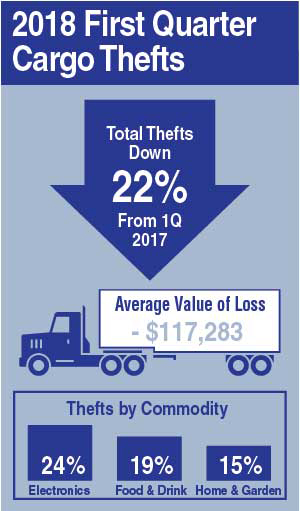Cargo Thefts Down, but Reporting Problems Remain

There were 115 cargo thefts in the United States in the first quarter with an average loss value per incident of $117,283, according to Sensitech’s SensiGuard Supply Chain Intelligence Center.
That represents a 22% decline in thefts and a 15% drop in theft values compared with the first quarter of 2017.
SensiGuard cautions that the incident numbers can rise due to reporting delays and that its report only includes cargo thefts reported by reliable sources, including transportation security councils, insurance companies and law enforcement organizations. Also, the report doesn’t include theft of trailers, containers or bobtail tractors.
Further, cargo theft statistics can be problematic because it is not mandatory for states and police departments to categorize an event as cargo theft in the FBI’s Uniform Crime Report category, said Mary Aftanas, director of operations for property, casualty and commercial with the National Insurance Crime Bureau in Des Plaines, Ill.

Thirty states, the Bureau of Indian Affairs and the National Institutes of Health submitted cargo theft data in the UCR in 2016, according to FBI’s 2016 Crime in the United States report.
In general, nonparticipating states have not made technical changes necessary to report the thefts in the UCR code, or they may not have the resources to conduct data quality checks on incidents associated with cargo theft, the FBI notes.
Still, the SensiGuard report provides a valuable view of major trends and events in the cargo theft arena.
The most prevalent place for large-scale thefts was unsecured parking areas, identified as the location in 92% of incidents where a location was declared. Secured parking areas and warehouses each accounted for 4% of theft locations, SensiGuard reports.
In the first quarter, the theft of full truckloads was by the far the most prevalent method of theft, accounting for 88% of all reported thefts. The average loss in a truckload theft was $126,624, a 15% increase from the first quarter of 2017.
The other types of theft are pilferage, accounting for 9% of all thefts in the first quarter; hijacking, 2%; and facility theft, 1%. There were no fictitious pickups.
SensiGuard reports thieves have been diverting loads by posing as shippers and contacting carriers in an attempt to change the destination of loads that already have been booked. The idea is to get the product dropped at an unsecured location, where it is easier for the crooks to drive off with the load.
Thieves are shifting to strategic theft and away from opportunistic theft, Aftanas said.
“They use countersurveillance and choose something they know is needed in the black market,” she said. “They watch a distribution center for certain products. When the time is right, they send in their person [in a truck] and tell him to pick up the load.”
The stolen goods may be sold in the United States or overseas, she said.
The most common type of product stolen was electronics, making up 24% of all thefts. California dominates here, accounting for 47% of all electronic thefts, followed by Texas with 8%. Electronics are especially attractive in the fourth quarter, when retailers stock televisions, game devices and similar products for the holidays. But a release of a new smartphone, tablet or special game console at any time of the year generates more thefts.
California saw 37% of all cargo thefts, making it the top state for incidents. Nearly a third of the thefts there were electronics and about 20% were home and garden products. Illinois became the second leading state for thefts, accounting for 13% of the total, a rise of 140% over the first quarter a year ago. Electronics made up 40% of thefts in the state.




